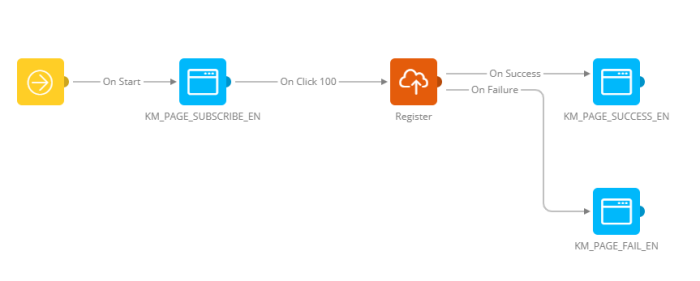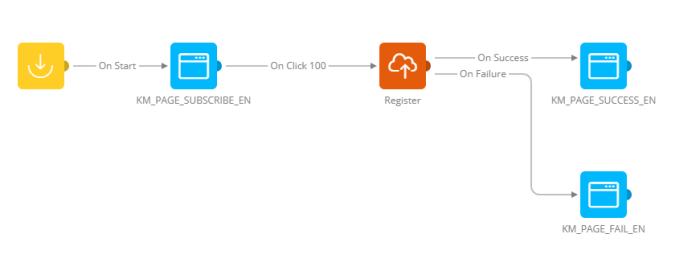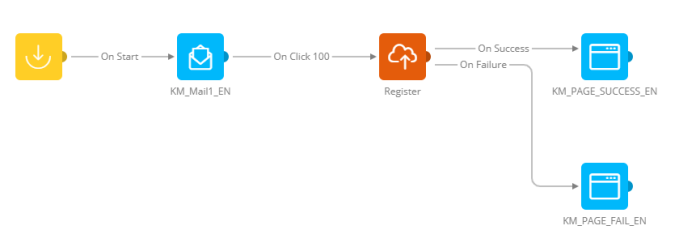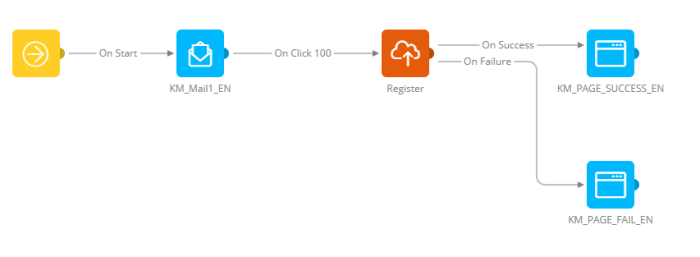Once a Custom Journey has been created, you can access the properties of the journey as well as the design area. The panel at the right hand side contains all components that can be added to the journey. Hover a component to display the tooltip.
When these components are used on the canvas, the icon colors are inverted.
Data
 Data
Component — Save
data in the database, in an Audience List or profile extension.
Data
Component — Save
data in the database, in an Audience List or profile extension.
 Lookup
Component — Look
for a specific contact in an Audience List using constraints.
Lookup
Component — Look
for a specific contact in an Audience List using constraints.
 Custom Component — Use either a Web or Stored Procedure Custom Component to manage data in the database.
Custom Component — Use either a Web or Stored Procedure Custom Component to manage data in the database.
 Validation Component — Validate a specific constraint and depending on the result choose a different path in the journey.
Validation Component — Validate a specific constraint and depending on the result choose a different path in the journey.
 Event Data Component — Save data in the database, but only in Custom Events Lists.
Event Data Component — Save data in the database, but only in Custom Events Lists.
Interaction
 Page — Page content shown to the contact.
Page — Page content shown to the contact.
 Email — Email being sent.
Email — Email being sent.
 SMS — The SMS content to be sent to the
mobile number of the contact.
SMS — The SMS content to be sent to the
mobile number of the contact.
 MMS — The MMS content to be sent to the
mobile number of the contact.
MMS — The MMS content to be sent to the
mobile number of the contact.
 RCS — The RCS content to be sent to the
mobile number of the contact.
RCS — The RCS content to be sent to the
mobile number of the contact.
 Mobile
Message — Notification
pushed to the mobile device and displayed on the lock screen and in the
message center.
Mobile
Message — Notification
pushed to the mobile device and displayed on the lock screen and in the
message center.
 Redirect — Redirects
contacts to another journey or external URL.
Redirect — Redirects
contacts to another journey or external URL.
 Meta Custom Audience — Adds contacts to the Meta Audience List.
Meta Custom Audience — Adds contacts to the Meta Audience List.
 Google Customer Match — Adds contacts to the Google Customer Match list.
Google Customer Match — Adds contacts to the Google Customer Match list.
 Snapchat Audience — Adds contacts to the Snapchat Audience.
Snapchat Audience — Adds contacts to the Snapchat Audience.
 X Tailored Audience — Adds contacts to the 'X' (formerly Twitter) Audience.
X Tailored Audience — Adds contacts to the 'X' (formerly Twitter) Audience.
 Custom Channel — Use any of the custom channels defined.
Custom Channel — Use any of the custom channels defined.
Entry points
 Input — Either the starting point of
the journey or an entry point to the journey.
Input — Either the starting point of
the journey or an entry point to the journey.
 Recurring
Batch — The entry
point of a journey that is executed repeatedly at a given time frame.
Recurring
Batch — The entry
point of a journey that is executed repeatedly at a given time frame.
 Single Batch — The entry point of a journey that is executed once.
Single Batch — The entry point of a journey that is executed once.
Event Entry points
 Custom Event — Entry point for event-driven journeys, to trigger Custom Event data defined in Audience Lists and react upon them.
Custom Event — Entry point for event-driven journeys, to trigger Custom Event data defined in Audience Lists and react upon them.
 Inbound Event — Currently used as an entry point for incoming SMS messages that can be scanned for keywords and acted upon accordingly.
Inbound Event — Currently used as an entry point for incoming SMS messages that can be scanned for keywords and acted upon accordingly.
 Retargeting Event — Entry point to Retargeting Journeys and automatically exposed for use in Site. Pages in this journey can be used for display on Site pages.
Retargeting Event — Entry point to Retargeting Journeys and automatically exposed for use in Site. Pages in this journey can be used for display on Site pages.
 Abandoned Cart Event — Entry point to Abandoned Cart Journeys that can be used in Site.
Abandoned Cart Event — Entry point to Abandoned Cart Journeys that can be used in Site.
Audiences
 Audience Filter
— Defines a filter
on the selected journey audience .
Audience Filter
— Defines a filter
on the selected journey audience .
Select & Optimize
 Rule Based Split —
Splits the journey path based on specific audience values .
Rule Based Split —
Splits the journey path based on specific audience values .
 Random Split — Splits the entire audience in different groups to follow a different path.
Random Split — Splits the entire audience in different groups to follow a different path.
 Wait —
Allows setting a delay on the execution of the next step.
Wait —
Allows setting a delay on the execution of the next step.
 Wave — Allows sending messages out in waves.
Wave — Allows sending messages out in waves.
 Sample — Allows sending messages to a sample of records in a list.
Sample — Allows sending messages to a sample of records in a list.
 Control Group — Allows splitting the audience in a test group and a control group.
Control Group — Allows splitting the audience in a test group and a control group.
 A/B Test — Allows testing different versions of a message and sending the winner to the remaining audience.
A/B Test — Allows testing different versions of a message and sending the winner to the remaining audience.
 Subject Line A/B Test — Allows testing different versions of a subject line in an email message and using the winning subject line in the email to be sent to the remaining audience.
Subject Line A/B Test — Allows testing different versions of a subject line in an email message and using the winning subject line in the email to be sent to the remaining audience.
 Delivery Optimization — Makes it possible to send out messages at an optimized send-time, when the contact is most likely to interact with the message, based on previous interactions (or a fallback STO time).
Delivery Optimization — Makes it possible to send out messages at an optimized send-time, when the contact is most likely to interact with the message, based on previous interactions (or a fallback STO time).
Miscellaneous
 Note — Allows adding notes to the Journey canvas.
Note — Allows adding notes to the Journey canvas.
Example : Create, configure and use a Custom Journey for a user registration flow





